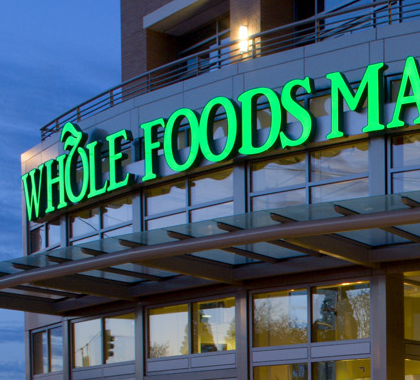Secretary of Commerce Wilbur Ross called Amazon’s recent $13.7 billion acquisition of Whole Foods a “clever move” because it marries Amazon’s marketing and distribution expertise with a “high-quality, niche retailer.” One suspects that perhaps Secretary Ross, a 79-year-old billionaire investor and art collector, doesn’t do a lot of grocery shopping.
More to the point, as to the “high quality” of Whole Foods’ operation and reputation, he might wish to check with his government colleagues at the FDA and Department of Justice, because Whole Foods’ violations of state and federal law have been escalating: They’ve gone from defrauding their customers in various ways to adopting food-preparation practices that actually endanger them.
The acquisition could benefit shareholders and consumers alike if Amazon repurposes Whole Foods’ vast store space, adding new kinds of capacity to its broader businesses. Consider, for example, the shelf space devoted to high-saturated-fat coconut oil, which Whole Foods last summer said was “(still!) trending [in a positive direction] — and for good reason.” Good reason, indeed. Whole Foods is partly to blame for 72 percent of Americans’ considering coconut oil to be a “healthy food,” compared with only 37 percent of nutritionists, according to a survey conducted by the polling firm Morning Consult and the New York Times. (It isn’t.)
Amazon’s growing dominance irks those who have a sentimental preference for shopping locally, even if that is at “local” behemoths such as Whole Foods and Lowe’s. But for those concerned about things like their grocery product’s “carbon footprint,” Amazon’s efficient approach is undoubtedly greener than the outmoded, illogical Whole Foods model.
Consider this: Last week, one of us (Jeff Stier) called Lowe’s to see if they had a specific Weber grill in stock, before driving ten miles round-trip to pick up the one item. While getting bounced around the store’s phone system and put on hold for the second time for more than three minutes, Jeff, who tries to be as efficient with his resources as he is with the earth’s, found the grill at Amazon.com. He ordered it, with free two-day delivery, at the same price he’d have paid at Lowe’s, whose employees didn’t pick up before Jeff completed his Amazon purchase and hung up the phone.
“But a grill isn’t an ethically and locally grown organic, non-GMO, gluten-free cherry,” a defender of Whole Foods might say. True, but when it comes to sound management, efficiency, and honest dealing with customers, Whole Foods has more in common with Lowe’s (or, for that matter, United Airlines) than Amazon.
Known sardonically as “Whole Paycheck” for its outrageous prices, Whole Foods has repeatedly been found guilty of widespread cheating. New York City Department of Consumer Affairs investigators found in 2015 that the company systematically ripped off unwitting customers by “routinely” overstating the weight of prepackaged foods — including meats, seafood, dairy, and baked goods. The co-CEO dismissed these thefts as “mistakes.”
That travesty followed an $800,000 settlement the previous year with the city attorneys of Los Angeles, Santa Monica, and San Diego after Whole Foods stores were found to be overcharging by not accounting for the weight of containers at their already overpriced salad bars.
Whole Foods bills itself as “America’s Healthiest Grocery Store,” even trademarking the term. Yet on June 8, 2016, in a devastating warning letter— one of the most severe compliance actions that the FDA has at its disposal — the FDA said Whole Foods was manufacturing, packaging, and storing food in ways that promoted contamination with microorganisms that cause food poisoning.
Among the long list of serious problems identified during multiple inspections in February 2016 at a 70,000-square-foot facility that supplied prepared foods and other products to 74 stores across eight states were foods such as pasta and mushroom quesadillas prepared or stored in places where condensation was dripping from ceilings, a doorway, and a fan.
In addition, the company kept dirty dishes near food, did not supply hot water at some hand-washing sinks, and allowed high-pressure hoses used for cleaning to spray food-preparation areas.
In 2015, Whole Foods had to recall batches of its curry-chicken salad and a pasta salad from East Coast stores after the products were found during a routine inspection of the same plant to be contaminated with a nasty bacterium called listeria. And last October, organic “micro greens” were recalledfrom Whole Foods because of salmonella contamination that was discovered not by the grower or Whole Foods but during a random check by the FDA.
This year (through June 19), Whole Foods has announced no fewer than 32 recalls, most often for undeclared allergens or pathogenic bacteria in its food products. These included cheeses made from raw, unpasteurized milk, a known hazard. The fact that many problems failed to be detected by Whole Foods’ quality-control systems strongly suggests that there are far more safety problems that we don’t know about.
There are other ways that Whole Foods fails to live up to its claims about being the “healthiest.” The company’s disingenuousness in providing information to its customers is as bad as its deficient food preparation and storage. Its website promotes the practice of homeopathy — including for treating illnesses in babies, some of which, including the flu, can be serious — even though homeopathy is pseudoscientific rubbish from the same mold as perpetual-motion machines. (And it ignores both that homeopathic products may actually be harmful and that for many illnesses there are “real” drugs that actually work.)
Central to the company’s grossly inflated pricing and popularity are misleading representations about its organic-food offerings. There is, for example, the holier-than-thou Whole Foods importing large amounts of its supposedly “organic” produce from China, of all places. Those imports even included Whole Foods’ house brand, “California Blend.” The company insists that China’s “organic” certification of its agricultural products is just as strict and reliable as that in the United States. If you believe that, we can offer you a terrific price on the Golden Gate Bridge — which, by the way, really is in California.
The company must have a low threshold for optimism, because it cites shoddy, cherry-picked research from biased sources.
For instance, it has cited “leading research” by the Organic Center, an outfit directed by organic-food and organic-supplement makers. Moreover, Whole Foods fails to acknowledge persuasive evidence that debunks the organic-is-healthier hoax. A widely publicized, peer-reviewed analysis published in 2012 in Annals of Internal Medicine by researchers at Stanford University’s Center for Health Policy aggregated and analyzed data from 237 studies to determine whether organic foods are safer or healthier than non-organic foods. They concluded that fruits and vegetables that met the criteria for “organic” were on average no more nutritious than their far cheaper conventional counterparts.
Whole Foods may have enjoyed financial success (at least until its share price began to decline in late 2014; it is currently off 36 percent from its high), but let’s not confuse doing well with doing good. Wells Fargo and the tobacco companies are cases in point.
Amazon changed the retail landscape by giving consumers what they want — convenience, reliability, value, and first-rate customer service. Reconciling that ethos with the current version of Whole Foods might not check out.
[Originally Published at the National Review]





